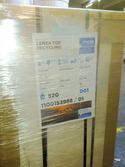How to resolve a sticky problem
24 August 2010Joanne Hunter reports on label release liner ‘recover and recycle’ schemes that are operating across Europe with potential to resolve a tricky waste issue for the self-adhesives sector.
The European self-adhesive label industry is promoting a revolutionary scheme that takes back and recycles post-consumer release liner. Cycle4Green’s proposition aims to resolve the sector’s underlying waste problem - a growing concern for at least 25 years.
C4G has operated since mid 2009 under the founder and President, Petri Tani, formerly with UPM’s labels business in Finland for many years.
Supporting the enterprise is Lenzing Papier, an Austrian paper company with impressive credentials in the recycled paper sector and access to worldwide markets.
The silicone-coated paper waste stream is not traditional recycling territory, but now it is being desiliconised and used successfully to produce recycled fine and speciality paper products.
Mr Tani explains: “Use of silicone coated waste paper in a standard de-inking plant requires some modifications to process and particularly to chemistry. To meet the requirements of both quality and capacity, some investments are needed. Lenzing Papier has now adopted this technology.”
As C4G sees it, there is a strong case in the UK for joining a collection scheme. “Tipping fees for waste are high in the UK,” remarks Mr Tani, and “our customers get a better solution, money-wise.”
The environmental case is persuasive, too. “In Europe, labelling consumes approximately 300,000 tonnes/year of siliconised paper, and now we get back only a small proportion of the entire amount of paper used.
“The industry is under pressure to solve its waste issue. In legislation recycling is still often reviewed as averaged volumes. And while filmic products are in many cases categorised, paper is ‘just paper’. This could change as regulations become tighter for speciality papers,” warns Mr Tani.
De-siliconised fibre in the C4G concept is directed to uses where the value is greater, such as face label papers, some types of release liners – clay coated, not glassine - and coated and uncoated fine papers and packaging papers.
The tricky parts of closing the loop are creating a collection infrastructure and adapting mill technology for integrating silicone-coated waste.
Recovery of silicone coated waste must be widespread across Europe, to be able to supply a paper mill with the required quantities and to keep logistics costs under control, says Mr Tani. “We must scale up collection. This is at the heart of our closed loop concept. Lowering unit costs is the only way to keep our programme running in the longterm.” But it will be hard to do, he knows, because of the entrenched behaviour patterns of label printers and commercial end-users.
But a guiding light for environmental leadership is brand owner Sara Lee, showing great commitment to diverting production waste from landfill and controlling its waste management costs. Krisztina Bordacs, Sara Lee’s Environmental Co-ordinator at the UK based Household and Body Care division, jumped at the chance to join a release liner take-back and recycle programme run by Channeled Resources (see Big Interview). It collects mostly from brand owners but also printers, and amalgamates their volumes into containers for shipping from Liverpool to India, where it is used to make toilet tissue. For several months some of Sara Lee’s sorted and prepared waste material has been diverted to Austria to become feedstock for Lenzing.
The scheme has helped Sara Lee cut its landfill volumes by 50% in two years, says Ms Bordacs. She notes that while the UK Government hs a target to divert 65% from landfill by 2015, the technical, supply chain and political support is generally lacking.
She believes it 'shameful', firstly, that India can use siliconised paper waste, whereas the UK does not; secondly, that often there is no better alternative to landfill than sending recyclables across an ocean. She thinks that if more customers were to publicise their participation, it would create economies of scale and improve overall cost efficiencies. Meanwhile, many other brand owners generating release liner waste are choosing to 'bury their heads in the sand', when tipping costs can only continue to rise, she says.
C4G’s founder adds that in his 24 years in the paper industry, ‘no one saw the issue as their own problem’, and it made him finally decide to jump into the role of an ‘individual facilitator’. Mr Tani urges the paper label sector, likewise, to be proactive: it is a threat to the paper industry if, due to cost, regulation compliance or convenience, brands switch to a form of decoration that excludes paper.
Finat, the body representing the selfadhesive labels sector, has pledged to raise awareness about C4G among its members and their customers, and to set up a link between end users and label printers with C4G ‘and other relevant solutions’.
Lenzing Papier processes release liner waste that Cycle4Green collects. Lenzing Desiliconised pulp goes into recycled fine and speciality paper products. Pulp External weblinksConverting Today is not responsible for the content of external internet sites.C4G Lenzing Finat Sara Lee



